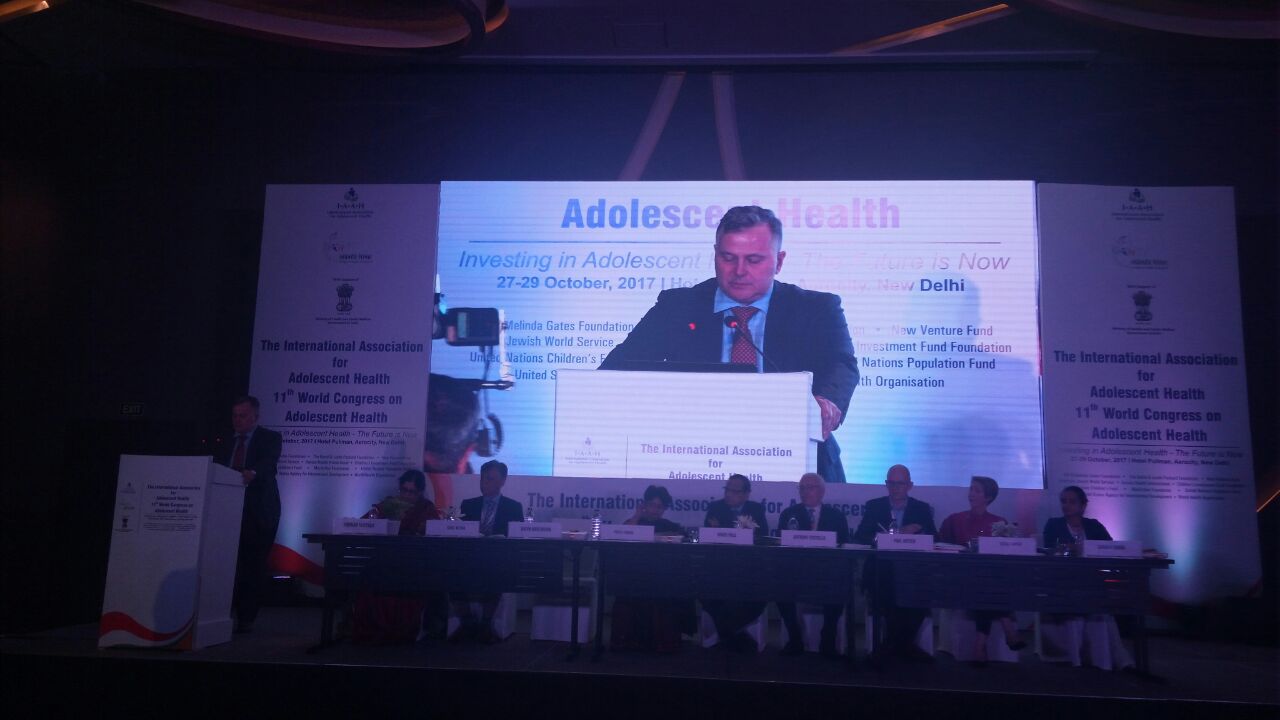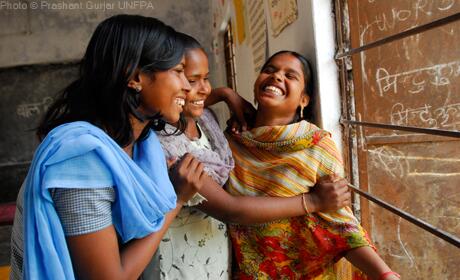Keynote address by Bjorn Andersson, UNFPA Regional Director for Asia and the Pacific, at the opening ceremony of the 11th World Congress on Adolescent Health, October 26, 2017, New Delhi, India
Ladies and gentlemen,
Thanks to the work of all of you present today, Adolescent Health is now firmly on the global agenda as an important issue – embedded as well in the 2030 Agenda for Sustainable Development underpinned by the Sustainable Development Goals.
The very fact that all of us are here underscores the importance of Adolescent Health for the global community – bringing together governments, the health sector and civil society, including, of course, youth representatives as well.
But, despite this, and allow me to be frank - in many ways we are still almost at the beginning.
In this, the 21st century, despite so many advances in health and with so much knowledge accumulated over the years, we see that more than 3000 adolescents still die every single day – that’s 1.2 million deaths a year -- from largely preventable causes including significant numbers of traffic accidents, suicide and pregnancy related deaths.
Why should this be? We need to ask ourselves tough questions, and provide honest answers.
Let’s consider the facts to better understand the context.
We have the largest population of young people ever in history. So many countries have the potential to reap what we call a demographic dividend. In this interconnected age, young people are linked up with each other – and with the world at large – as never before. This has opened up new possibilities, new horizons that people of my generation – from both developed and developing countries – could scarcely have dreamed of.
But for countries to achieve the demographic dividend – and for young people to realize the tantalizing possibilities – we must act swiftly to invest in young people strategically and compassionately, and, equally important, to genuinely partner with young people themselves in shaping our collective future.
This means investing wisely, from the very beginning of life, in the basic pillars of well-being and prosperity – health and education, linked, of course, to opportunities for gainful employment. If young people are to shape our social and economic development in an optimal way, they must be healthy, educated and – eventually - employed.
Far too often, these investments in health and education begin to dwindle when childhood gives way to adolescence – and even further when adolescence transitions into adulthood. This results in harmful outcomes in terms of health and education, in terms of employment opportunities and prospects, and, overall, in terms of a country’s socio-economic future.

At this Congress, UNFPA will present the important results of an adolescent investment case which brings all these points together. This case makes it abundantly clear that investing in the health and development of adolescent girls and boys is one of the best investments a country can make from a socio-economic point of view. An investment of just $5 per capita each year to improve the health of adolescents will save an estimated 12.5 million lives, prevent more than 30 million unwanted pregnancies, avert widespread disability and result in economic and social benefits that are 10 times the cost – a truly significant return on investment.
Ladies and gentlemen, a safe and successful passage from childhood to adolescence, and from adolescence to adulthood, is not only economically and socially beneficial – it is also the right of every human being.
A critical part of this passage is reaching sexual and reproductive maturity. Each and every one of the 1.2 billion adolescents around the world today will go through puberty, the biological onset of adolescence. Some will be well-prepared, but many, many others will be woefully unprepared for this new and challenging phase in their lives.
Particularly for adolescent girls, this is a crucial time, a momentous turning point.
In recent decades, more and more girls the world over have been able to continue their education, acquire the information along with the social and emotional skills they need to negotiate safe and pleasurable sexual relationships, choose their own marital partners, decide if and when to start a family, have options for decent employment and play important roles in the community.
But for many other girls this is simply not the case. 130 million girls are out of school. One in four adolescent girls still face child or early marriage, with two-thirds of these girls in this region of Asia. For many girls their first sexual experience is coerced - and one in three girls will face intimate partner violence at some point in her lifetime. And 16 million adolescent girls give birth every year, with maternal death being the highest cause of death in adolescents globally.
Quite frankly, ladies and gentlemen, adolescent girls and their rights are being left behind, undermining the vision and the pledge of the SDGs which all countries have signed up to – that of leaving no one behind.
Repeating a question from earlier: Why should this be? Especially when we have the solutions, as clearly illustrated by the Lancet Commission on Adolescent Health and Wellbeing.
For instance, we know that keeping girls in school reduces adolescent pregnancy by over 9 births per 1000, for every additional year of school. We have seen marked reductions in child marriage globally through a range of multi-sectoral approaches. And we know that we now need to reach the poorest and the rural communities to end child marriage.
We also have clear evidence that implementing comprehensive sexuality education, starting in early primary school and with a strong focus on gender equality, enables boys and girls to have the communication skills and respect they need for each other, along with self-respect and a respect for diversity. Comprehensive sexuality education imparts critical information and builds and strengthens decision-making skills, so that adolescents can decide to delay sex or make choices that are safe and consensual. But can we honestly say that comprehensive sexuality education is being taught well in all schools in any country?
Let me be frank again. We will not progress in reducing gender inequality, including the manifestation of gender-based violence, nor will we progress in reducing adolescent pregnancy, if we do not fully commit to scaling up quality comprehensive sexuality education. Let us find ways to come together on this issue, and give it the importance it deserves if we are to solve many of the challenges of adolescent health and well-being today.
Last, but far from least, as we increase the investment and scale up all of our interventions, we need to recognize and engage adolescents and young people as important allies in the design and implementation of our programmes. Or, should I say, “their” programmes – for this is indeed about young people, their lives, their issues, their futures.
“Nothing for us without us “- the young people tell us loud and clear, but are we getting the message? Genuine inter-generational dialogue is key to making progress together.
UNFPA has made a sincere effort to partner with young people in more than 150 countries and territories around the world to promote their participation and leadership, enabling them to overcome barriers, spearhead innovations and unleash their full potential. We ask each and every one of the organizations here to join us in that effort – and if you are already part of the effort, to strengthen your involvement even further and bring others along.
Ladies and gentlemen, in conclusion:
Partnering with and investing in the largest generation of adolescents and youth in the history of the world is the most effective way to support developing countries faced with emerging challenges.
A tenfold return on investment in adolescent health and development is a powerful economic argument.
But it is not all about economics - let us not lose sight of the rights of the adolescent girl, who is most likely to be left behind.
We need to listen to adolescents now and we need to act now – and together.
Addressing the needs of adolescents benefits not only adolescents today, but their lives as adults of the future - and the next generation thereafter as well, born to our current generation of healthier, happier adolescents.
In short – the theme of this Congress: “Investing in Adolescent Health - the Future is Now.”
Thank you.
Note: Bjorn Andersson delivered a shortened version of this address; this is the original version.
The 11th World Congress on Adolescent Health runs from October 27-29, 2017, in New Delhi, India


